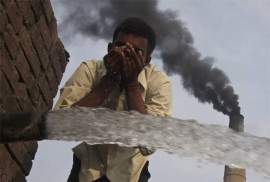
It is immediately obvious that the cricket players we see on advertisements around this time every four years probably make a lot of money during this time. One would even be able to conjecture that the channel actually broadcasting the match also makes money.
Less obvious might be the fact that even media outlets not directly broadcasting the World Cup also make money. Perhaps even more surprising is that rates for advertisements apparently do not go up during this time. So how exactly does everybody make more money? Here is a look at some of what goes on.
The mechanics of endorsement
Cricket players in Pakistan are perennial stars and thus normally get endorsement deals year round, regardless of whether or not the team is actually playing any games. The World Cup, however, is a different animal altogether. A much larger proportion of consumer goods companies choose to make their advertising campaigns revolve around cricket and spend heavily on them.
According to sources familiar with the matter, the actual rates charged by players for endorsement deals do not change substantially during the World Cup. But because the amount of money they get is based on the duration and intensity of the advertising campaign as well as the variety of mediums (television, radio, print) that it appears on, they make more money simply by virtue of the fact that there are more cricket-related ads.
Sources inside the industry suggest that Wasim Akram can charge as much as Rs2.5 million for his appearances in an ad, and that number is likely to go up depending on how many places and how often the ad appears. Shahid Afridi, on the other hand, seems more comfortable with yearly contracts that deliver a stable income, reportedly charging around Rs3 million for a year’s worth of his appearance in shampoo ads.
By comparison, the most famous non-cricketing athlete in Pakistan, tennis player Aisam ul Haq, charges a meagre Rs1 million for an endorsement contract.
Making it rain on the media
Despite higher viewership, broadcasters of cricket matches reportedly do not charge more per advertising spot, especially to companies with whom they have established relationships, such as the mobile telecommunications providers and most of the large consumer goods companies. But as with endorsements, media outlets make money simply by having more spots to charge for.
For example, Geo Super, the broadcaster with exclusive cable transmission rights for the World Cup matches in Pakistan, charges Rs56 million for a “joint presentation” campaign — meaning a company has to pay that much if it was to say “Geo Super and Company X present the Cricket World Cup.”
There are also those annoying ticket side-spot ads that make most viewers hate watching the match on Geo Super and why those of us fortunate enough not to have WorldCall as our cable provider still watch it on Star Cricket. But those are lucrative for the broadcaster, which is reportedly able to charge around Rs20,000 for a ten-second ad.
Broadcasters that not the only media outlet that makes money off the World Cup, though. Given the fact that many companies ramp up their advertising spending during cricket season, newspapers, magazines and radio stations tend to get more sponsors than usual, especially for their coverage of cricket. As with broadcasters, however, it appears that the driver of higher revenues is not increased rates but a greater volume of ads.
The downside
Not every business is particularly happy about the World Cup but perhaps most peeved are cinema owners. Anecdotal evidence gathered from cinema employees in Karachi suggest that ticket sales at some theatres drop by more than half during cricket season and vanish altogether on the day of a Pakistan match. While you may like the fact that some of Pakistan’s matches are on a weekend, you friendly local cinema owner probably does not.
The picture for restaurants is a little more mixed. Those eateries with large television screens seem to do a roaring business during World Cup season, particularly during the days of important matches, and not just when Pakistan is playing. Proprietors, however, seemed unwilling to disclose exactly how much more business they were doing.
On the other hand, some of the quieter places — those that one might go to for more intimate outings — seem to be struggling to fill up their tables on game nights, especially since the ICC seems to have decided to make most of the more-anticipated matches on weekends during this tournament. Given that restaurants tend to do most of their business on weekends, fewer customers on weekends has a disproportionately negative impact on their bottom line.
And while there are no comprehensive studies to prove this, many people suspect that productivity at most service sector businesses declines sharply during the World Cup. Trading on the Karachi Stock Exchange, for example, seems to be lower on days that Pakistan is playing a match on a weekday. As a newspaper editor, I can testify to the fact that reporters can be surprisingly difficult to get hold of during a Shahid Afridi bowling spell.
So is it good?
Given these observations about how the World Cup impacts individuals and businesses, is it really good for the economy? I would answer that question, but Umar Gul just bowled a beautiful Yorker. I am going to watch the rest of the match now.
Published in The Express Tribune, Sunday Magazine, March 20th, 2011.


1727177459-0/BeFunky-collage-(6)1727177459-0-165x106.webp)


1732697578-0/Untitled-design-(5)1732697578-0-270x192.webp)











COMMENTS
Comments are moderated and generally will be posted if they are on-topic and not abusive.
For more information, please see our Comments FAQ